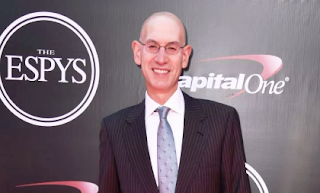The National Basketball Association (NBA) currently has 30 teams competing with each other. These teams are also competing with other forms of entertainment.
That’s reflected through the entire system, including revenue sharing and the salary cap itself. If those 30 teams were isolated actors rather than a unified business, it’d probably be illegal to conspire to cap employees’ wages.
But, again, sometimes they’re 30 teams competing with each other.
That inherent conflict plays out when teams rest players, usually on the road. The visiting team is making a strategic decision to maximize its on-court performance in the long-term. The home team’s fans will have a lower-quality product that night.
NBA commissioner Adam Silver, via SiriusXM NBA Radio:
Left out of Silver’s argument: Teams frequently rest players on back-to-backs, and most back-to-backs occur on the road.
Still, his overall premise is sound: Resting players on road undermines the cooperation that makes the NBA so profitable. Teams that rest players more are essentially free riders, relying on the marketability of other players to boost the league’s revenue.
Silver is also correct that a rule banning resting players at home would produce more negative unintended consequences than positive intended consequences. Parsing when players are actually injured as opposed to just needing rest would be an enforcement nightmare.
So, Silver is doing what he can – being open to the need for rest, reducing the number of back-to-backs. Finding the exact formula is tricky, but it sounds as if Silver is soundly considering the issues at hand.
That’s reflected through the entire system, including revenue sharing and the salary cap itself. If those 30 teams were isolated actors rather than a unified business, it’d probably be illegal to conspire to cap employees’ wages.
But, again, sometimes they’re 30 teams competing with each other.
That inherent conflict plays out when teams rest players, usually on the road. The visiting team is making a strategic decision to maximize its on-court performance in the long-term. The home team’s fans will have a lower-quality product that night.
NBA commissioner Adam Silver, via SiriusXM NBA Radio:
"I get it for those disappointed fans. Part of me would prefer that, if you’re going to rest a player, rest him for the home fans, because they get to see that player all the time. But on the other hand, I recognize it’s matchup specific. Once again, I’m not sure that having an absolute rule that if a player is rested, he must be rested at home works either. So, it’s not an easy issue to resolve."A flaw in Silver’s logic: Home fans in a particular city are a different set of people each game. Many fans attend just a few times, or even once, per year.
Left out of Silver’s argument: Teams frequently rest players on back-to-backs, and most back-to-backs occur on the road.
Still, his overall premise is sound: Resting players on road undermines the cooperation that makes the NBA so profitable. Teams that rest players more are essentially free riders, relying on the marketability of other players to boost the league’s revenue.
Silver is also correct that a rule banning resting players at home would produce more negative unintended consequences than positive intended consequences. Parsing when players are actually injured as opposed to just needing rest would be an enforcement nightmare.
So, Silver is doing what he can – being open to the need for rest, reducing the number of back-to-backs. Finding the exact formula is tricky, but it sounds as if Silver is soundly considering the issues at hand.


No comments:
Post a Comment